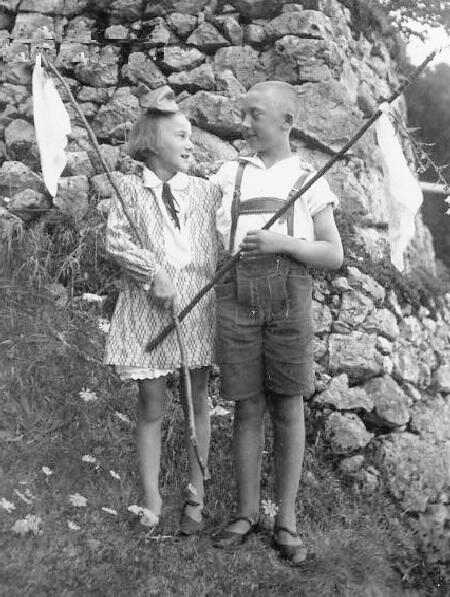
German Children's Footwear: Gender Trends

Fogure 1.--These German children probably in the early-1930s wear the same footwear. I am not sure about the German worn for them, but they look to be a kind of soft strap shoe. German children wore them at the time wore them as a play shoe, much like modern children wear sneakers. THis is complicated by the fact taht the same style was also used for dress occassions. .
|
|
Gender is another important factor to consider when studying German footwear. we note German boys and girls wearing a wide range of footwear. These styles and the gender conventions associated with them have varied widely over time. Today boys and girls tend to wear destinctive footwear, although sneakers can be similar. This has not always beeen the case. At times it was very common for boys and girls, especially younger boys and girls to wear the same footwear styles. At other times boys and girls wore very different footwear styles. The same is true of the basic footwwae styles. This includes the various types of sandals as well as the dfferent types of shoes. Various aspects of footwear have been used to develop gender distinctions. This has included footwear type, styling, decoration, and color. We have found images of most of these aspects in the photographic record, except of course color. Here we do not find maby examples efoe the 1970s. Here the black and white photography of the day makrs it very difficult to assess color. The one exception is white which can be identified in the blaxk and white photography
Styles
Gender is another important factor to consider when studying German footwear. we note German boys and girls wearing a wide range of footwear. These styles and the gender conventions associated with them have varied widely over time. This is the case for both basic footwwae styles as well as specialized styles like dress and play foowear. This includes the various types of sandals as well as the dfferent types of shoes.
Chronology
Today boys and girls tend to wear destinctive footwear, although sneakers can be similar. This has not always beeen the case. At times it was very common for boys and girls, especially younger boys and girls to wear the same footwear styles. At other times boys and girls wore very different footwear styles. Basically the gender sconventions bevame more fixed agter Wirld War II in the 1950s.
Styling and Decoration
Various aspects of footwear have been used to develop gender distinctions.
We have found images of most of these aspects in the photographic record, except of course color. Here we do not find maby examples efoe the 1970s. Here the black and white photography of the day makrs it very difficult to assess color. The one exception is white which can be identified in the blaxk and white photography. White and to a lesser rxtent black or the two colors that can be idntified in thd black-and-white photograpohic record of the 19th and early- and mid-20th century. White is fairly easy to identify. Black is a little more difficult. Unfortunately we know nothing about color. It sinmply can not ve derived from the photographic record. White we can identify, and whilr tounger boys might wear white footwear, it was primarily a color worn by girls. We can see thids very clearly in the pohotographic record. There was, however some variation over time., especially in the early-20th century. White was mostly ued for strap shoes, bith regular strap shoes and sandals.
HBC

Navigate the Boys' Historical Clothing German pages:
[Main German footwear page]
[German art]
[German catalogs]
[German choirs]
[German movies]
[German royalty]
[German school uniforms]
[German youth groups]
[German sailor suits]
[Lederhosen]
[Ethnic]
[Tights]
[Long stockings]
Navigate the Boys' Historical Clothing Web Site:
[Introduction]
[Activities]
[Biographies]
[Chronology]
[Clothing styles]
[Countries]
[Bibliographies]
[Contributions]
[FAQs]
[Glossary]
[Images]
[Links]
[Registration]
[Tools]
[Boys' Clothing Home]
Created: 11:28 PM 10/22/2008
Last updated: 2:22 AM 5/22/2015



